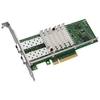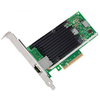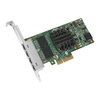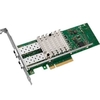-
Home
-
Contributors
-
International
-
Account
-
Information
More From Contributor
- it just works! Specifications Device Type Network adapter Form Factor Plug-in card
- low profile Interface (Bus) Type PCI Express 2.0 x 8 Ports 10 G Base-SR Cabling Type Ethernet 10 G Base-SR Data Link Protocol Gig E, 10 Gig E, FCo E Data Transfer Rate 10 Gbps Network / Transport Protocol TCP/ IP, UDP/ IP, IPSec, i SCSI Processor 82599ES
- Intel ...
Includes:: new power management technologies such as Energy Efficient Ethernet (EEE) & DMA Coalescing (DMAC). Intel I350 Gigabit Ethernet Controller With PCI Express V2.0 (5 GT/s) support Halogen-free (copper) Low-profile (dual & quad port copper; dual-port fiber) & standard height (quad-port fiber) DMA coalescing Intel i SCSI remote boot for Windows, Linux, & VMware Eight transmit (Tx) & receive (Rx) queue pairs per port Flexible Port Partitioning: 32 Virtual Functions on Quad-port Support for PCI-SIG SR-IOV
Specification Rx/ Tx round-robin scheduling ...
- Max link distance is 300 m) Optic is a SFP+ module designed for the Intel Ethernet Converged ...
Colour: Black Weight (Approximate): 8.00 oz ...
Intel Ethernet Server Adapter I350-F2
connectivity to deliver I/O virtualization and Quality of Service (QoS) features designed directly into the I350 controller on the adapter. I/O virtualization advances network connectivity models used in the servers to more efficient models by providing Flexible Port Partitioning (FPP), multiple Rx/Tx queues, and on-controller QoS functionality that can be used in both virtual and non-virtual server deployments. Scalable iSCSI performance Intel Ethernet I350 Server Adapter with native iSCSI initiators provides a simple, dependable, cost-effective way to connect to LANs and iSCSI SANs. These native initiators are broadly tested using multiple generations of operating systems, storage systems, and OS tools to help ensure reliability and ease of use. Standardizing on Intel Ethernet for iSCSI
allows administrators to use a single initiator, TCP/IP stack, and a common set of management tools and IT policies. Energy Efficient Ethernet (EEE) The Intel Ethernet I350 Server Adapter family supports the IEEE802.3az Energy Efficient Ethernet (EEE) standard so that, during periods of low network activity, EEE reduces the power consumption of an Ethernet connection by negotiating with a compliant EEE switch port to transition to a low power idle (LPI) state. This reduces the controller power to approximately 50% of its normal operating power, saving power on the network port and the switch port. As soon as increased network traffic is intelligently detected, the controller on the platform and the switch quickly come back to full power to handle the increased network traffic. DMA
coalescing Another power management technology that can reduce power on the server platform is DMA Coalescing (DMAC). Typically, when a packet arrives at a server, DMA calls are made to transfer the packet within the server. These calls wake up the processor, memory and other system components from a lower power state in order to perform the tasks required to handle the incoming packet. Based on the configurable DMAC settings, incoming packets are buffered momentarily before any DMA calls are made. This enables the controller to intelligently identify opportunities to batch multiple packets together so that when components are wakened from lower power states they can efficiently handle the batched packets at the same time. This enables platform components to remain in lower power states
longer, which can dramatically reduce platform energy consumption.
- External links may include paid for promotion
- Availability: In Stock
- Supplier: Ebuyer Business
- SKU: 321409
Product Description
The new Intel Ethernet Server Adapter I350-F2 builds on Intel's extended history of excellence in Ethernet products. Intel continues its market leadership with this new generation of PCIe Gb E network adapters. Built with the bridgeless Intel I350 Ethernet Controller, these adapters represent the next step in the Gb E networking evolution for the enterprise & data center by introducing new levels of performance through industry-leading enhancements for both virtualized & i SCSI Unified Networking environments. This new family of adapters also
Includes:: new power management technologies such as Energy Efficient Ethernet (EEE) & DMA Coalescing (DMAC). Intel Ethernet
- It just works! Flexible I/O Virtualization The Intel Ethernet I350 adapter
Includes:: Intel Virtualization technology for connectivity to deliver I/O virtualization & Quality of Service (Qo S) features designed directly into the I350 controller on the adapter. I/O virtualization advances network connectivity models used in the servers to more efficient models by providing Flexible Port Partitioning (FPP), multiple Rx/ Tx queues, and on-controller Qo S functionality that can be used in both virtual & non-virtual server deployments. Scalable i SCSI performance Intel Ethernet I350 Server Adapter with native i SCSI initiators provides a simple, dependable, cost-effective way to connect to LANs & i SCSI SANs. These native initiators are broadly tested using multiple generations of operating systems, storage systems, and OS tools to help ensure reliability & ease of use. Standardizing on Intel Ethernet for i SCSI allows administrators to use a single initiator, TCP/IP stack, and a common set of management tools & IT policies. Energy Efficient Ethernet (EEE) The Intel Ethernet I350 Server Adapter family supports the IEEE802.3az Energy Efficient Ethernet (EEE) standard so that, during periods of low network activity, EEE reduces the power consumption of an Ethernet connection by negotiating with a compliant EEE switch port to transition to a low power idle (LPI) state. This reduces the controller power to Approx. 50% of its normal operating power, saving power on the network port & the switch port. As soon as increased network traffic is intelligently detected, the controller on the platform & the switch quickly come back to full power to handle the increased network traffic. DMA coalescing Another power management technology that can reduce power on the server platform is DMA Coalescing (DMAC). Typically, when a packet arrives at a server, DMA calls are made to transfer the packet within the server. These calls wake up the processor, memory & other system components from a lower power state in order to perform the tasks required to handle the incoming packet. Based on the configurable DMAC settings, incoming packets are buffered momentarily before any DMA calls are made. This enables the controller to intelligently identify opportunities to batch multiple packets together so that when components are wakened from lower power states they can efficiently handle the batched packets at the same time. This enables platform components to remain in lower power states longer, which can dramatically reduce platform energy consumption.
Reviews/Comments
Add New
Intelligent Comparison
Price History
Vouchers
Do you know a voucher code for this product or supplier? Add it to Insights for others to use.


 United Kingdom
United Kingdom
 France
France
 Germany
Germany
 Netherlands
Netherlands
 Sweden
Sweden
 USA
USA
 Italy
Italy
 Spain
Spain


















 Denmark
Denmark